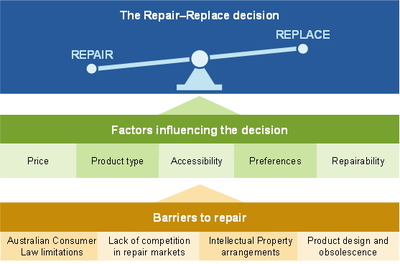Who should decide who can repair a product?
Friday, 18 June, 2021

Should the owner of a product be able to repair what they have bought or does the manufacturer retain that right?
The Australian Government commissioned the Productivity Commission, its independent research agency, to look at what can be done to address growing concern that products are becoming harder to repair, leading to higher costs, greater inconvenience for consumers and growing waste. A ‘right to repair’ is the ability of product users to have their products repaired at a competitive price using a repairer of their choice.
Realising this aspiration in a practical way involves a range of policies, including consumer and competition law, intellectual property protections, product design and labelling standards, plus environmental and resource management. It is calling for further information and feedback from the community to inform its final report, which will be delivered to government in October 2021. A draft report was released last June for comment from stakeholders.
For industry there are concerns that some manufacturers are making it difficult for consumers and independent repairers to repair goods, such as by not providing repair information, tools or spare parts. This can give manufacturers the ability to increase the price of repair and reduce the choice of repairers.
The Commission is considering ways to make it easier for independent repairers to access the things they need to repair goods. The proposed reforms would improve a user’s right to repair, without the uncertainty and costs associated with more forceful policy interventions.
One approach could be to change copyright law to allow independent repairers to legally access and share copyright information such as manuals and diagnostic information. Another approach could be to require manufacturers to provide independent repairers and consumers with access to repair information, tools or spare parts. This may be more beneficial for certain products, such as agricultural machinery or mobile phones and tablets. However, the evidence base on the magnitude of repair barriers in these markets is patchy and largely anecdotal, preventing a rigorous assessment of whether additional policies would provide net benefits to the community.
Warranties should be made clearer to inform users that even if they use independent repairers, they will not lose legal rights. The Commission is also considering a ban on voiding warranties if consumers do not use the manufacturer’s repairer.
The Commission is seeking further evidence on other reforms that could help users obtain repairs and make more informed purchase choices. These potential reforms involve:
- requiring manufacturers to provide software updates for a reasonable period
- amending copyright laws to enable third‑party repairers to copy and share repair manuals, and access repair data hidden behind digital locks
- prohibiting manufacturer warranties from being voided if consumers do not use the repairers and spare parts specified by the manufacturer
- developing a product durability or repairability labelling scheme to help consumers identify products that best meet their needs.
The Commission is seeking evidence on the net benefits of a more extensive right to repair policy through a ‘positive obligation’ that would require manufacturers to provide third‑party access to repair information and supplies.
According to the report, some responses from manufacturers state that their repair information is proprietary, or that there are safety and other concerns resulting from the use of information by unskilled repairers.
2025–26 Thought Leaders: Tim Karamitos
Tim Karamitos from Ericsson discusses the connectivity requirements of emergency services and...
2025–26 Thought Leaders: Ruth Tovo
Comms Connect panellist Ruth Tovo, from the South Australian SES, discusses the technical...
ARCIA update: celebrating excellence in our industry
The ARCIA Annual Gala Dinner and Excellence Awards took place during the same week as Comms...




